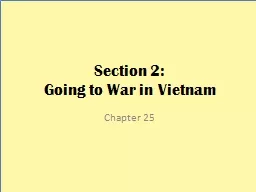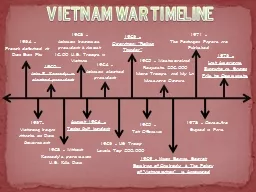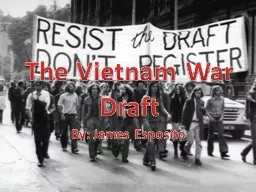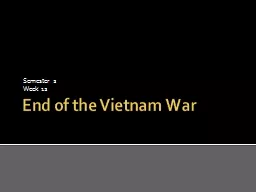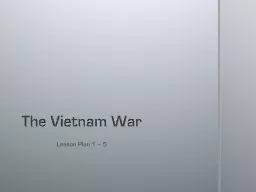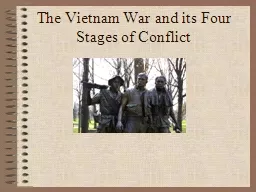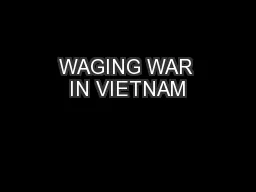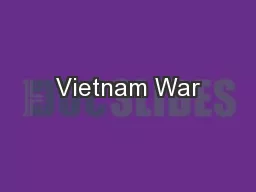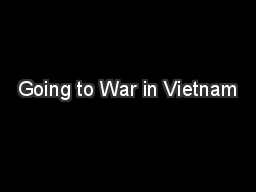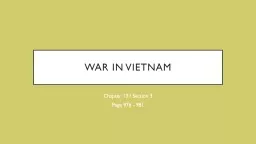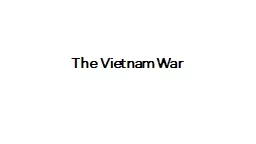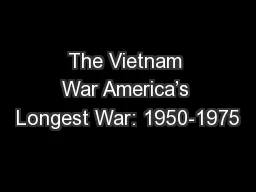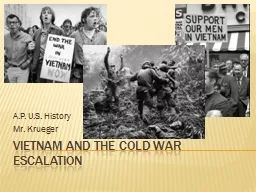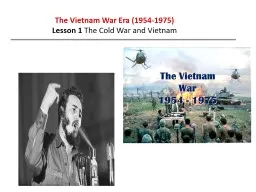PPT-Section 2: Going to War in Vietnam
Author : mitsue-stanley | Published Date : 2019-12-13
Section 2 Going to War in Vietnam Chapter 25 Diems Hamlets One program Diem introduced only made matters worse S Vietnamese created strategic hamlets special fortified
Presentation Embed Code
Download Presentation
Download Presentation The PPT/PDF document "Section 2: Going to War in Vietnam" is the property of its rightful owner. Permission is granted to download and print the materials on this website for personal, non-commercial use only, and to display it on your personal computer provided you do not modify the materials and that you retain all copyright notices contained in the materials. By downloading content from our website, you accept the terms of this agreement.
Section 2: Going to War in Vietnam: Transcript
Section 2 Going to War in Vietnam Chapter 25 Diems Hamlets One program Diem introduced only made matters worse S Vietnamese created strategic hamlets special fortified villages Villages were protected by machine guns bunkers trenches and barbed wire. What was it?. The Vietnam War was . a war that had . C. ommunist North . Vietnam and its southern . allies, the . Viet Cong, . fighting against . South . Vietnam and the . United States. .. The war ended in 1973 because of the withdrawal of United States help.. 1960 -. John F. Kennedy is elected president. 1963 -. Johnson becomes president & almost 16,00 U.S. Troops in Vietnam. 1964 -. Johnson elected president. 1957-. Vietcong began attacks on Diem Government. By: James Esposito. The Draft for the Vietnam War was Immoral. Many Americans were burning their draft cards and protesting against the war, which hadn’t been very popular in American history to this point. Semester 2. Week 12. The Vietcong is Born. After Ngo Dinh Diem refused to hold Nat'l elections, Ho Chi Minh & his followers began an armed struggle to reunify the nation; they organized a new guerrilla army, which became known as the . Lesson Plan 1 – 5. Beginnings of War. 1953: Eisenhower greatly increases aid to France in fighting Vietnam. May 1961. President Kennedy sends 400 Green Berets “Special Advisors” to South Vietnam to train South Vietnam soldiers on methods of counter-insurgency. Overview. Pretest. Timeline. BIO’S: Ho Chi Minh & Ngo Dinh Diem. The Language of War. The First Vietnam War. Reasons for US Involvement. Exploring The Four Stages . Why did America lose?. Pictures. What made fighting difficult. ?. Jungle . terrain. Who is the enemy? Viet Cong. Unfamiliar terrain & enemy has intricate network of tunnels. Enemy is more motivated. Unpopular war at home. Cultural differences. Chapter 22. Section 1. Beginning. 1950. French Indochina War. France = trying to gain control back in Vietnam after WWII. America Supports France . Massive economic aide. France ruled. Vietnam. Laos. The Vietnam War. Ho Chi Minh and his followers began . an armed struggle to reunify the nation. . They organized a new guerrilla army, which became known as the Vietcong.. President Eisenhower increased American aid, and sent hundreds of military advisers to train South Vietnam’s army.. Page 976 - 981. Timeline. 1945: Yalta Conference / US drops atomic bombs on Japan. 1947: Truman Doctrine / Marshall Plan. 1949: NATO formed. 1950: Korean War starts (ends in 1953). 1955: Warsaw Pact. Who was the Vietnamese nationalist that became the leader of North Vietnam during the Vietnam War?. Mao . Tse. -Tung. Tu. Thong. Ho Chi Minh. Ngo . Dinh. Diem. Who . was president in 1955 when the US began acting as an advisor to South Vietnam?. Conquest and colonialism in Indochina. 200 B.C. Chinese invade Red River Delta. 939 A.D. After nearly 1000 years of Chinese control, the Vietnamese win independence but the Chinese remained a threat. A.P. U.S. History. Mr. Krueger. Filling in the Gaps…. Flexible Response. Berlin Wall. Containment in S.E. Asia. Bay of Pigs. Cuban Missile Crisis. War on Poverty. Great Society. Medicare. Voting Rights Act 1965. The Vietnam War Era (1954-1975) Lesson 1 The Cold War and Vietnam Learning Objectives Explain the steps Kennedy took to change American foreign policy. Analyze the causes and effects of the Bay of Pigs invasion and the Cuban Missile Crisis.
Download Document
Here is the link to download the presentation.
"Section 2: Going to War in Vietnam"The content belongs to its owner. You may download and print it for personal use, without modification, and keep all copyright notices. By downloading, you agree to these terms.
Related Documents

